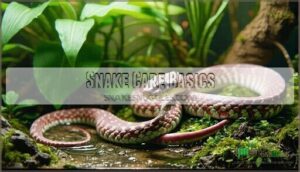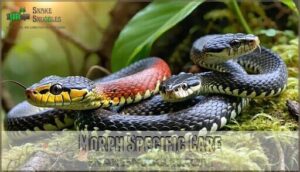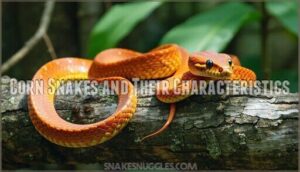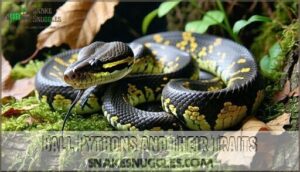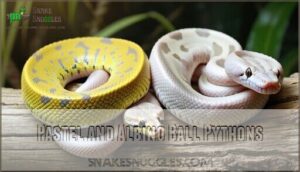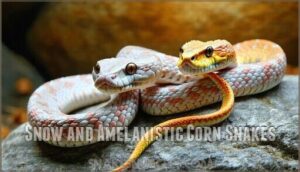This site is supported by our readers. We may earn a commission, at no cost to you, if you purchase through links.
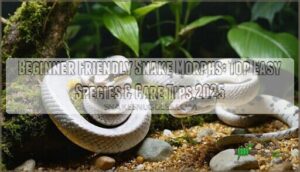 You’ll find beginner friendly snake morphs in corn snakes, ball pythons, and California kingsnakes.
You’ll find beginner friendly snake morphs in corn snakes, ball pythons, and California kingsnakes.
Corn snakes offer the easiest care with morphs like snow and amelanistic varieties that don’t require special lighting needs. Ball pythons bring docile temperaments through pastels and champagnes, though they’re pickier eaters.
California kingsnakes sport striking banded patterns while staying incredibly hardy. Avoid spider morphs and other neurological variants as your first snake.
Start with captive-bred specimens from reputable breeders who’ll provide health records and feeding charts. These species tolerate handling mistakes better than exotic varieties, making them perfect stepping stones into the hobby.
The secret lies in matching morph characteristics with your experience level.
Table Of Contents
- Key Takeaways
- Choosing Beginner Snakes
- Snake Care Basics
- Morph Specific Care
- Beginner Friendly Species
- Popular Morphs for Beginners
- Frequently Asked Questions (FAQs)
- What is the easiest snake for a beginner?
- What’s the friendliest snake to own?
- What is the most interactive pet snake?
- Is a ball python or corn snake better for beginners?
- What health problems affect specific snake morphs?
- How do genetics work in snake breeding?
- Can different snake species live together safely?
- What veterinary care do pet snakes need?
- How much does snake ownership cost annually?
- Conclusion
Key Takeaways
- Start with hardy species like corn snakes or ball pythons – they’re forgiving of beginner mistakes, have docile temperaments, and don’t require special lighting needs like more exotic varieties.
- Choose captive-bred specimens from reputable breeders – you’ll get health records, feeding charts, and ongoing support, which makes a huge difference when you’re learning proper snake care.
- Avoid complex morphs like spider varieties – stick with simple genetics like pastel ball pythons or amelanistic corn snakes that don’t have neurological issues or special care requirements.
- Budget for a proper setup from day one – you’ll need an appropriate enclosure size, temperature gradients, and humidity control, with most beginner morphs costing $20-120 plus setup expenses.
Choosing Beginner Snakes
Starting your snake journey doesn’t have to be overwhelming when you choose the right beginner-friendly species and morphs.
You’ll find that hardy varieties like corn snakes and ball pythons offer stunning color variations while being forgiving to new keepers who are still learning proper care techniques, which makes them a great choice for those looking for forgiving pets.
Hardy Species for Beginners
Looking for hardy species that won’t punish beginner mistakes? Corn snakes top the list – these beginnerfriendly champions reach 3-5 feet with docile temperaments and 15-20 year lifespans.
Ball pythons offer calm handling differences and manageable enclosure size needs. Rosy boas tolerate frequent interaction with simple feeding habits.
These easy snake morphs handle temperature fluctuations better than delicate species, making them perfect starter choices. Vets often recommend corn snakes due to their docile and calm temperament.
Importance of Reputable Breeders
Choosing the right breeder makes all the difference for beginner snake morphs.
You’ll want someone who prioritizes animal welfare over quick profits.
Smart breeders provide thorough support throughout your snake’s life.
Look for these key qualities:
- Health guarantees with transparent return policies
- Ethical breeding practices focusing on genetic diversity
- Documentation provided including lineage and morph authenticity papers
- Transparent practices allowing facility visits and open communication
- Breeder communication offering ongoing guidance and care advice
Reputable sources guarantee you’re getting healthy animals with proper genetic lineage verification.
Some beginners opt for species like the docile Ball Python due to their temperament.
Researching State Regulations
Before owning beginner snake morphs, you’ll need to navigate state regulations and local ordinance checks.
Most states allow nonvenomous species but require ownership permit types for certain sizes or exotic pet laws compliance.
Virginia restricts native species to one per address, and it’s essential to check breeder licensing details and interstate transport rules with local wildlife agencies to avoid legal issues.
Popular Beginner Morphs
After determining which species fit your budget and local laws, you’ll want beginner-friendly snake morphs that combine visual appeal with handling ease.
Pastel and yellow belly ball pythons offer stunning colors while maintaining docile snake breeds‘ temperament.
Normal corn snakes provide excellent morph availability at low beginner costs, typically under $50.
These popular snake pets demonstrate superior morph health compared to complex genetics, making them ideal easy to care snakes for new keepers learning proper husbandry techniques.
Strong feeding responses indicate a healthy morph.
Snake Care Basics
Once you’ve chosen your beginner-friendly snake, setting up proper care becomes your next essential step for ensuring your new pet thrives in captivity.
Getting the basics right from day one prevents common health issues and creates a foundation for years of successful snake keeping.
Setting Up Enclosures
Your snake enclosure serves as their entire world, so getting it right matters. Start with a 10-20 gallon tank for juveniles, upgrading as they grow.
Your snake’s entire world fits in one tank—make it count from day one.
Choose substrate options like aspen shavings or reptile carpet for easy cleaning. Install hiding spots on both warm and cool sides—snakes need secure retreats.
Proper thermostats are essential for safety. Make certain proper ventilation systems prevent stagnant air while maintaining temperature control throughout the enclosure.
Thermal Gradient and Humidity
Your snake’s comfort depends on creating proper thermal gradients and humidity control.
Temperature range matters – establish basking temperatures at 88-92°F while maintaining cool zones at 75-80°F.
Humidity levels need consistent monitoring with digital hygrometers.
Key temperature gradients for healthy snakes:
- Warm side: 88-96°F for digestion
- Cool side: 70-80°F for thermoregulation
- Basking spot: 90-95°F surface temperature
- Night temps: Can drop to 70-75°F safely
Humidity monitoring prevents shedding issues and supports respiratory health.
Most beginner species thrive at 50-60% humidity.
Consider using a reliable heat source to maintain proper basking temperatures.
Feeding and Handling Techniques
Feed your snake frozen-thawed prey matched to its widest body section every 7-14 days.
Juveniles eat weekly, adults biweekly.
Using pre-killed reptile diets guarantees safety and convenience.
Use feeding tongs and wash hands before gentle handling sessions.
Skip handling for 48 hours post-feeding to prevent regurgitation.
Avoid disturbing snakes during shedding periods when their eyes appear milky blue.
Cleaning and Maintenance
Daily spotclean waste removal keeps your snake healthy while monthly deepclean routines prevent bacterial buildup.
Remove feces and urates immediately, then sanitize water dishes with hot soapy water.
Monthly enclosure maintenance includes full substrate replacement and accessory sanitization.
Using the right cleaning products is vital for reptile safety and this preventative care approach maintains prime enclosure hygiene and reduces disease risks substantially.
Morph Specific Care
While each snake morph shares basic care requirements, specific color variations have unique needs that can make or break your success as a new keeper.
Understanding these differences now will save you from costly mistakes and guarantee your snake thrives with its distinct genetic traits.
Pastel Morph Requirements
Why do pastel morphs captivate so many beginners? These beginnerfriendly snake morphs showcase stunning color vibrancy through bright yellows and subtle blushing patterns.
Pattern maintenance requires temperature consistency between 72-96°F across thermal zones. Humidity control at 50-60% prevents poor sheds that dull their beauty.
Snake care basics include 20-gallon tanks for juveniles, expanding to 40+ gallons for adults. Beginnerfriendly snakes have minimal lighting needs—standard room lighting works perfectly for these beginnerfriendly snakes, making them a great choice with standard room conditions.
Albino Morph Sensitivities
Behind the beauty of albino morphs lies a hidden vulnerability that new keepers must understand.
Beautiful snakes hide delicate needs that demand your careful attention.
These photosensitive snake morphs require careful albino lighting management to thrive as beginner-friendly snake morphs options.
Key Albino Morph Care Requirements:
- Lighting Needs – Use subdued lighting and avoid direct sunlight to prevent eye discomfort and skin burns
- UVB Concerns – Skip high-UV bulbs that can cause cataracts and accelerate vision problems
- Temperature Control – Maintain consistent thermal zones without harsh basking lights
- Humidity Levels – Monitor closely during shedding when skin health becomes critical for albino morphs
Mojave Morph Temperature Needs
Mojave ball pythons need three distinct temperature zones to thrive.
Create a cool zone at 72-80°F, warm hide at 80-85°F, and basking spot at 88-96°F.
These Mojave gradients guarantee proper thermoregulation.
Night drops to 70°F are safe.
Use reliable heating methods with thermostat calibration for temperature control.
Proper humidity levels also play a vital role.
Without proper temperature gradients, these beginner-friendly snakes may refuse food or develop digestive issues.
Enclosure Enrichment and Stress Reduction
Beyond temperature management, you’ll need basic enclosure enrichment to create a stress-free environment for your snake.
Empty boxes and paper tubes provide hiding places while encouraging natural exploration behaviors.
Add climbing opportunities like branches or cork bark to stimulate mental activity.
Substrate variety, from coconut husk to cypress mulch, lets your snake control its microenvironment.
These naturalistic elements reduce handling stress substantially.
Beginner Friendly Species
You’ll find choosing your first snake becomes straightforward when you focus on these four species known for their forgiving nature and simple care requirements.
These hardy options handle beginner mistakes gracefully while offering beautiful morphs that won’t break your budget.
Corn Snakes and Their Characteristics
Corn snake ownership brings together docile temperament with stunning visual appeal, making these beginner snake species perfect first reptiles.
You’ll appreciate their easy to care snakes nature and vibrant morphs ranging from classic oranges to snow whites.
These docile snakes rarely bite and tolerate beginner handling sessions well.
Adult enclosure size requirements stay manageable at 40 gallons for their 3-5 foot length, and their reliable feeding habits accept frozen-thawed rodents consistently, making them a great choice with reliable feeding habits.
Ball Pythons and Their Traits
Champions in the reptile world, ball pythons earn their reputation through exceptional python temperament and calm nature.
These docile snake breeds rarely exceed 5 feet, making them perfect easy to care snakes for standard enclosures.
Their shy personalities mean they’ll curl into defensive balls when stressed, but ball python morphs adapt well to gentle handling.
Beginner snake species don’t get much better than these reliable feeders.
Rosy Boas and Their Handling
Rosy boas make ideal beginner-friendly snakes for new keepers. Their docile temperament and minimal bite risk create perfect conditions for learning safe techniques.
Key handling advantages:
- Size matters – At 2-3ft adult length, they’re less intimidating than larger species
- Gentle nature – Their boa temperament allows frequent handling without stress
- Regional variations – Different color patterns add visual interest while maintaining easy care
Start with 5-minute sessions and gradually increase handling frequency as your confidence grows.
King Snakes and Their Care Needs
After years of selective breeding, Lampropeltis getula proves why it’s among the most beginnerfriendly snakes available.
King Snake morphs display excellent Kingsnake Temperament, tolerating regular handling sessions.
You’ll need standard Enclosure Size requirements (40-gallon for adults) with secure lids since they’re escape artists.
Their Feeding Habits accept frozen-thawed prey every 10-14 days.
Common Illnesses remain minimal with proper snake care. Proper ventilation is essential for preventing respiratory issues.
Morph Variations include banded patterns that captivate new keepers.
Popular Morphs for Beginners
When choosing your first snake morph, you’ll want to balance stunning visual appeal with easy care requirements.
Popular beginner-friendly morphs like Pastel ball pythons and Snow corn snakes offer vibrant colors without the complex care needs or high price tags of exotic varieties.
Pastel and Albino Ball Pythons
Ball python morphs offer stunning visual appeal with beginner-friendly care requirements.
Pastel genetics create bright yellow tones and distinctive blushing patterns that intensify with proper husbandry.
Albino morphs display striking white scales with pink undertones but require careful lighting management due to photosensitivity.
Both morphs cost $75-100, making them affordable starter options.
- Pastel morphs showcase enhanced color vibrancy through dominant genetics, creating reliable breeding outcomes
- Albino photosensitivity requires avoiding harsh UVB lighting to prevent eye damage and stress
- Pattern variations in both morphs offer unique aesthetics while maintaining docile ball python temperament
- Beginner costs remain reasonable at $75-100, with normal morphs available for even less
- Color vibrancy develops fully with consistent temperatures and proper humidity management
Snow and Amelanistic Corn Snakes
Snow corn snakes showcase stunning white scales with pink undertones, while amelanistic morphs lack dark pigment entirely.
These beginner-friendly options share corn snakes’ docile temperament and easy care requirements.
Snow genetics combine albino and anerythristic traits, creating a pristine appearance that’s visually striking yet simple to maintain.
Both morph variations thrive with standard husbandry—no special lighting or temperature adjustments needed like sensitive albino ball pythons require, making them a great option for those who want easy care.
High Yellow and Albino Leopard Geckos
While corn snakes offer stunning patterns, leopard geckos present different beginner-friendly options with unique Gecko Genetics.
High Yellow morphs display bright golden tones, while Albino varieties showcase pale pink eyes and reduced pigmentation.
These docile species require smaller Enclosure Size than snakes, making them perfect for limited space.
Their Diet Variety includes crickets and mealworms rather than rodents.
Both morphs represent easy care choices, though potential Health Issues require monitoring.
Starter Friendly Morphs and Their Prices
Smart buyers know that five affordable snake morphs deliver exceptional value for beginners.
When considering morph affordability and beginner budgets, these beginnerfriendly options offer the best snake for beginners without breaking the bank:
- Normal Ball Python – $50-75, perfect for learning easy care basics
- Pastel Ball Python – $75-100, stunning colors with simple requirements
- Normal Corn Snake – $20-40, most affordable snake morphs available
- Amelanistic Corn Snake – $30-60, beautiful albino features
- Mojave Ball Python – $80-120, excellent morph prices for intermediate keepers
These pricing factors reflect morph popularity and availability, ensuring value appreciation over time.
Frequently Asked Questions (FAQs)
What is the easiest snake for a beginner?
For beginners, consider corn snakes your best bet. They’re docile, forgiving with care mistakes, and eat frozen-thawed rodents reliably. You’ll appreciate their 20-year lifespan and stunning color variations.
What’s the friendliest snake to own?
Ball pythons and corn snakes are your friendliest options. They’re naturally calm, rarely bite, and become comfortable with gentle handling. Ball pythons especially tolerate beginner mistakes well.
What is the most interactive pet snake?
Like a friendly neighborhood dog that’s always enthusiastic to greet you, ball pythons stand out as the most interactive pet snakes.
They’re calm, curious, and actually seem to recognize their owners over time.
Is a ball python or corn snake better for beginners?
Corn snakes edge out ball pythons for absolute beginners.
They’re more forgiving with temperature mistakes, eat consistently, and cost less.
Ball pythons can be pickier eaters and stress easily, though both make excellent starter snakes.
What health problems affect specific snake morphs?
Albino morphs suffer from photosensitivity requiring careful lighting management. Pastel and Mojave morphs need consistent temperatures to maintain vibrant colors. All morphs can develop respiratory infections from poor humidity control.
How do genetics work in snake breeding?
Snake genetics follow predictable inheritance patterns where traits pass from parents to offspring through dominant, recessive, and co-dominant alleles. You’ll see simple ratios when breeding morphs together.
Can different snake species live together safely?
No, you shouldn’t house different snake species together. Snakes are naturally solitary and can transmit diseases, parasites, or stress-related behaviors to each other, creating dangerous competition for resources.
What veterinary care do pet snakes need?
You’ll need annual checkups, fecal exams for parasites, and emergency care for respiratory infections or shedding problems. Find an exotic veterinarian experienced with reptiles before you need one.
How much does snake ownership cost annually?
You’ll spend $200-500 annually on snake ownership. Food costs $50-150, substrate and bedding $30-80, electricity for heating $60-120, and vet checkups $50- Initial setup costs extra.
Conclusion
Like a well-maintained terrarium that flourishes with the right conditions, choosing beginner friendly snake morphs sets you up for long-term success in reptile keeping.
Start with hardy species like corn snakes or ball pythons, which forgive care mistakes while you learn.
Focus on captive-bred specimens from reputable breeders who’ll support your journey, and remember, the right morph paired with proper research creates a rewarding experience that’ll likely lead to expanding your collection in years ahead.
- https://community.morphmarket.com/t/best-cheap-beginner-snake-that-can-fit-in-a-snake-rack-thats-not-a-garter-or-ball-python/35151
- https://www.xyzreptiles.com/what-are-the-best-beginner-snakes/
- https://www.petmd.com/reptile/corn-snake-care-sheet
- https://ghostconstrictors.com/blogs/news/top-10-beginner-ball-python-morphs
- https://www.zenhabitats.com/blogs/reptile-care-sheets-resources/most-popular-ball-python-morphs-top-10-must-see

